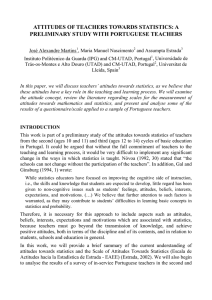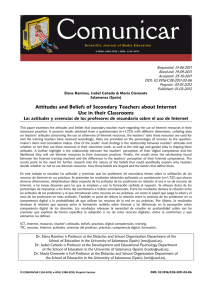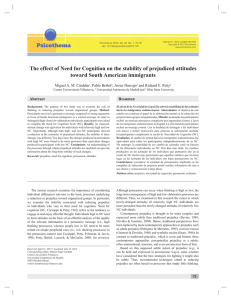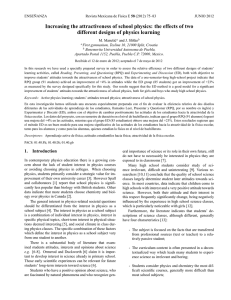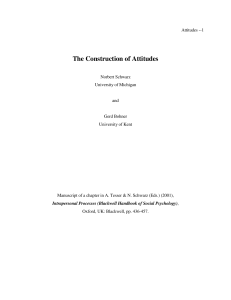A functional approach to the study of environmental attitudes1 Un
Anuncio
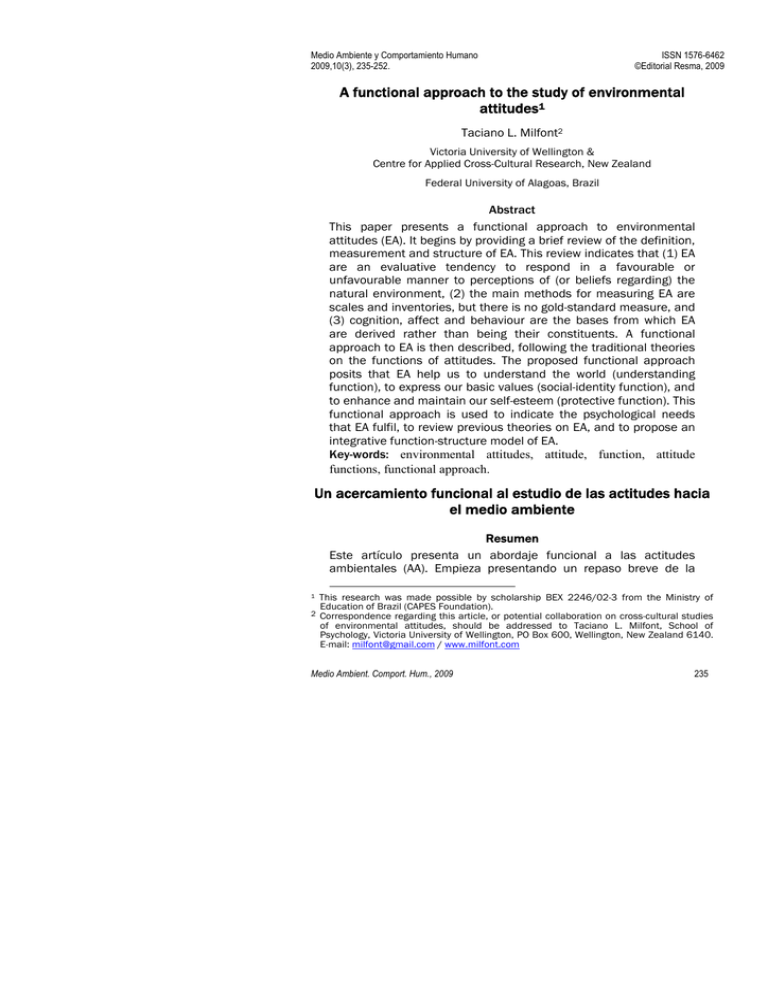
Medio Ambiente y Comportamiento Humano 2009,10(3), 235-252. ISSN 1576-6462 ©Editorial Resma, 2009 A functional approach to the study of environmental attitudes1 Taciano L. Milfont2 Victoria University of Wellington & Centre for Applied Cross-Cultural Research, New Zealand Federal University of Alagoas, Brazil Abstract This paper presents a functional approach to environmental attitudes (EA). It begins by providing a brief review of the definition, measurement and structure of EA. This review indicates that (1) EA are an evaluative tendency to respond in a favourable or unfavourable manner to perceptions of (or beliefs regarding) the natural environment, (2) the main methods for measuring EA are scales and inventories, but there is no gold-standard measure, and (3) cognition, affect and behaviour are the bases from which EA are derived rather than being their constituents. A functional approach to EA is then described, following the traditional theories on the functions of attitudes. The proposed functional approach posits that EA help us to understand the world (understanding function), to express our basic values (social-identity function), and to enhance and maintain our self-esteem (protective function). This functional approach is used to indicate the psychological needs that EA fulfil, to review previous theories on EA, and to propose an integrative function-structure model of EA. Key-words: environmental attitudes, attitude, function, attitude functions, functional approach. Un acercamiento funcional al estudio de las actitudes hacia el medio ambiente Resumen Este artículo presenta un abordaje funcional a las actitudes ambientales (AA). Empieza presentando un repaso breve de la 1 2 This research was made possible by scholarship BEX 2246/02-3 from the Ministry of Education of Brazil (CAPES Foundation). Correspondence regarding this article, or potential collaboration on cross-cultural studies of environmental attitudes, should be addressed to Taciano L. Milfont, School of Psychology, Victoria University of Wellington, PO Box 600, Wellington, New Zealand 6140. E-mail: [email protected] / www.milfont.com Medio Ambient. Comport. Hum., 2009 235 A functional approach to the study of environmental attitudes definición, medida y estructura de las AA. Este repaso indica que (1) las AA son una tendencia evaluativa a contestar de un modo favorable o desfavorable a la percepción de (o las creencias respecto) al ambiente natural, (2) los métodos principales para medir las AA son escalas e inventarios, pero no existe una medida padrón-oro, y (3) la cognición, el afecto y la conducta son las bases de las cuales son derivadas las AA, en lugar de ser sus constituyentes. Un abordaje funcional de las AA es luego descrito, siguiendo las teorías tradicionales sobre las funciones de las actitudes. El abordaje funcional propuesto establece que las AA ayúdanos a comprender el mundo (entendimiento funcional), expresar nuestros valores básicos (función de identidad-social), y promover y mantener nuestra autoestima (función de protección). Este abordaje funcional es empleado para indicar las necesidades psicológicas a que las AA sirven, repasar teorías previas sobre estas actitudes y proponer un modelo integrativo de su funciónestructura. Palabras clave: actitudes ambientales, actitud, función, funciones actitudinales, abordaje funcional Introduction Functional approaches to psychological constructs are not uncommon. In fact, there is a very strong functional tradition to the study of attitudes (Katz, 1960; Smith, Bruner, & White, 1956), and functional approaches have also been proposed to the study of other psychological constructs, such as values (Allen, Ng, & Wilson, 2000; Gouveia, Milfont, Fischer, & Santos, 2008) and social axioms (Leung & Bond, 2004). However, there has been no previous attempt to propose such approach to environmental attitudes (EA). The present paper addresses this gap in the literature by proposing a functional approach to the study of EA. The goal of the present paper is twofold. First, it reviews and summarizes the functional accounts to attitudes in general. This review is then used to develop a functional approach to EA. This functional approach is used to describe the psychological needs that EA fulfil, to guide a review of previous studies of EA, and also to develop a functionstructure model in which the structure and functions of EA are related. This paper begins by presenting a brief review of three main topics in attitudes research: their definition, measurement, and structure. 236 Medio Ambient. Comport. Hum., 2009 Taciano L. Milfont Before going further, there is a point worth noting. Heberlein (1981) argues that technically “any object outside of self exists in the individual’s environment, so all attitudes except those beliefs about self could be correctly called environmental attitudes” (p. 243). Thus, EA may refer to attitudes toward all external objects of one’s reality. Moreover, “environment” may refer to both built and non-human environments. To avoid over-generalization and confusion, the concept of EA is here used to designate only attitudes toward the natural (biophysical or non-human) environment, except as noted. Psychological study of attitudes and environmental attitudes This section briefly reviews the psychological literature on attitudes and EA, specifically addressing their definition, measurement and structure. It is not intended to be a comprehensive review of the study of attitudes, but rather an introduction to the most essential issues addressed in this paper regarding the functions of EA. Definition of attitudes and environmental attitudes Attitude, from Latin aptus (i.e., fit and ready for action), has been one of the main psychological constructs studied in social psychology. Indeed, many prominent psychologists have referred to social psychology as the scientific study of attitudes (Thomas & Znaniecki, 1918; Watson, 1930), or at least have elected attitude as the most indispensable concept of this discipline (Allport, 1935). There are many attitude definitions (e.g., Allport, 1935, p. 810), and attitudes have been conceptualized and researched in different ways. However, there seems to be a current general consensus that attitudes can be viewed as an evaluative judgement summary of attribute dimensions (e.g., good-bad, likabledislikable) of a particular psychological object (Ajzen, 2001; Albarracín, Zanna, Johnson, & Kumkale, 2005; Crano & Prislin, 2006; Eagly & Chaiken, 1993, 2005). Following this approach, Eagly and Chaiken (1993) have defined attitudes as “a psychological tendency that is expressed by evaluating a particular entity with some degree of favor or disfavor" (p. 1, emphasis in original). This definition is regarded as the contemporary definition of attitudes (Albarracín, Johnson, & Zanna, 2005). Similarly, several definitions for EA have been proposed (see, e.g., Dunlap & Jones, 2002, p. 483; Dunlap & Michelson, 2002, p. 485; Medio Ambient. Comport. Hum., 2009 237 A functional approach to the study of environmental attitudes Gallagher, 2004, p. 97; Heberlein, 1981, p. 5; Schultz, Shriver, Tabanico, & Khazian, 2004, p. 31; Yin, 1999, p. 63). Moreover, many researchers have used “environmental concern” and “environmental attitudes” synonymously (Dunlap & Jones, 2003; Van Liere & Dunlap, 1981), whereas others have differentiated them (Heberlein, 1981; Schultz et al., 2005; Schultz et al., 2004; Stern & Dietz, 1994). However, given that “environmental attitudes” is the preferred term in psychological studies of environmental issues (Dunlap & Jones, 2002), it seems the best term in psychological research (cf. Gallagher, 2004). Taking into account Eagly and Chaiken’s (1993) attitudes definition presented above, a new and more economic definition of EA has been proposed: Environmental attitudes are a psychological tendency that is expressed by evaluating perceptions of (or beliefs regarding) the natural environment, including factors affecting its quality, with some degree of favour or disfavour (Milfont, 2007b, in press). Measurement of attitudes and environmental attitudes Attitudes are a latent construct and as such cannot be observed directly. Thus, rather than being directly measured, attitudes have to be inferred from overt responses (Himmelfarb, 1993). The techniques of attitude measurement can be broadly organized into direct self-report methods and implicit measurement techniques (Krosnick, Judd, & Wittenbrink, 2005). Direct self-reports are based on questionnaires that explicitly ask participants to indicate their own attitudes, and hence may be referred to as explicit measurement techniques. These techniques are the most used procedure for measuring attitudes and three main techniques have been used. These are: Thurstone’s method of equalappearing intervals, Likert’s method of summated ratings, and Osgood’s semantic differential (for reviews of these techniques, see Krosnick et al., 2005). However, in direct self-report methods participants are consciously aware of the attitude researchers are measuring and the purpose of the measurement, and this may influence their evaluative responses. To reduce such self-presentation biases, researchers have developed implicit measurement techniques. These include unobtrusive behavioural observation, physiological measures, and response latency measures (for reviews, see Himmelfarb, 1993; Krosnick et al., 2005). Studies in environmental psychology have relied more on subjective measures such as attitudes and cognitions about the environment, than 238 Medio Ambient. Comport. Hum., 2009 Taciano L. Milfont objective measures such as direct measures and manipulation of objects (Sundstrom, Bell, Busby, & Asmus, 1996). Following this tradition, studies measuring EA have generally used direct self-report methods (e.g., interviews and questionnaires), and much less frequently implicit techniques (e.g, observation, priming and response competition measures). In fact, by comparison, a far greater number of studies have used direct self-report techniques for measuring EA (Corral-Verdugo, 1997). The three self-report measures of EA that have been widely used are (Dunlap & Jones, 2003; Fransson & Gärling, 1999; Hawcroft & Milfont, 2008): the Ecology Scale (Maloney & Ward, 1973; Maloney, Ward, & Braucht, 1975), the Environmental Concern Scale (Weigel & Weigel, 1978), and the New Environmental Paradigm Scale (Dunlap & Van Liere, 1978; Dunlap, Van Liere, Mertig, & Jones, 2000). By contrast, only few studies have used implicit techniques for measuring EA and/or ecological behaviour, such as observations (Corral-Verdugo, 1997), priming (Van Vugt & Samuelson, 1999) or implicit, response competition (Schultz et al., 2004) measures. Despite the considerable number of measures in the field, there is no accepted gold-standard measure in the literature. Milfont and Duckitt (2008) developed the Environmental Attitudes Inventory (EAI) as a psychometrically sound, multi-dimensional inventory to assess EA crossculturally. The EAI comprises a comprehensive list of twelve scales that captures both the vertical and horizontal structure of EA (discussed below), and has shown acceptable reliability and validity in samples from Brazil, New Zealand, and South Africa. Thus, the EAI has the potential to become the gold-standard EA measure. Structure of attitudes and environmental attitudes Regarding the structure of attitudes, the most widely-held view has been the three-component model (Breckler, 1984; Rosenberg & Hovland, 1960). This model assumes that attitudes have cognitive, affective, and behavioural components. Nevertheless, contemporary theorists tend to hold that cognition, affect and behaviour are in fact the bases from which the general evaluative summary of a particular psychological object is derived, instead of being constituents of attitudes (Eagly & Chaiken, 1993; Fabrigar, MacDonald, & Wegener, 2005). Therefore, even though the three-component model remains the traditional view of attitude structure, new theoretical approaches prefer to conceptualise attitudes Medio Ambient. Comport. Hum., 2009 239 A functional approach to the study of environmental attitudes as evaluative tendencies that can both be inferred from and have an influence on beliefs, affect, and behaviour (Albarracín, Zanna et al., 2005). The structure of EA has also been extensively addressed (for a review, see Milfont, 2007a). Some studies have examined the structure of EA in term of the traditional three-component model of attitudes (Maloney & Ward, 1973; Maloney et al., 1975; Yin, 1999). For example, Maloney et al.’s (Maloney & Ward, 1973; Maloney et al., 1975) Ecology Scale has items measuring the cognitive (i.e., knowledge subscale), affective (i.e., affect subscale), and behavioural (i.e., verbal commitment and actual commitment subscales) components of attitudes. Other studies have examined the structure of EA in terms of value-based dimensions (e.g., Schultz, 2001; Stern & Dietz, 1994; Thompson & Barton, 1994). Overall, however, contemporary approaches have indicated the multidimensional and hierarchical nature of EA (Carman, 1998; Milfont & Duckitt, 2004, 2006; Wiseman & Bogner, 2003; Xiao & Dunlap, 2007). But what does it mean? First, it means that the perceptions or beliefs people have regarding the natural environment are relatively large, but that they can be operationalized in terms of dimensions, or psychological constructs. So, EA have a multidimensional nature because these attitudes can be expressed in terms of several dimensions. Second, it means that one can assess how these dimensions relate to each other, and how they can be grouped into fewer dimensions. So, EA also have a hierarchical nature because the dimensions that underlie these attitudes are grounded in fewer values. The multidimensional and hierarchical nature of EA expresses their horizontal and vertical structures, respectively. The horizontal structure refers to the number of specific evaluating perceptions of or beliefs regarding the natural environment that underlie the overall EA, and the vertical structure refers to the hierarchical cognitive organization of the horizontal structure. In psychometric terms, the horizontal structure refers to the primary order or first-order factor(s) forming the structure of EA, while the vertical structure refers to the higher order or second-order factor(s) (Milfont, 2007a). Recent research (Milfont, 2007b; Milfont & Duckitt, 2006) has shown that the horizontal structure of EA is comprised by at least twelve core dimensions. These dimensions are: (1) Enjoyment of Nature, (2) Support for Interventionist Conservation Policies, (3) Environmental Movement 240 Medio Ambient. Comport. Hum., 2009 Taciano L. Milfont Activism, (4) Conservation Motivated by Anthropocentric Concern, (5) Confidence in Science and Technology, (6) Environmental Fragility, (7) Altering Nature, (8) Personal Conservation Behaviour, (9) Human Dominance Over Nature, (10) Human Utilization of Nature, (11) Ecocentric Concern, and (12) Support for Population Growth Policies. These twelve dimensions are grounded in either a single (i.e., Generalized Environmental Attitudes) or two correlated values (i.e., Preservation and Utilization), which comprise the vertical structure of EA. To summarise, the most contemporary approach to attitude definition and structure consider attitudes as a global evaluative continuum in which affect, beliefs and behaviours influence this evaluative summary rather than being their parts. Following this most contemporary approach, it has been argued that EA are expressed by evaluative tendencies and that their structure is based upon these evaluative tendencies, which can both be inferred from, and have an influence on beliefs, affects and behaviours regarding human-environment relations (Milfont, 2007b). Moreover, direct self-report techniques, such as scales and inventories, are the most widely used methods for measuring both attitudes and EA. Although three EA measures have been usually employed, there is no accepted gold-standard measure in the literature. This can change with recent development in the area (cf. Milfont & Duckitt, 2008). Functions of attitudes Functional approaches address “the reasons and the purposes, the needs and the goals, the plans and the motives that underlie and generate psychological phenomena” (Snyder & Cantor, 1999, p. 642). In particular, functional approaches to attitudes focuses on the reasons one evaluate, or the psychological needs that attitudes serve (Maio & Olson, 2000a). Although several attitude functions have been proposed (see Maio & Olson, 2000b; Pratkanis, Breckler, & Greenwald, 1989), the classical analyses of attitude functions were proposed originally by Smith, Bruner and White (1956) and Katz (1960). Smith and colleagues (1956) proposed that attitudes can serve one or some combination of three functions: object appraisal, social-adjustment, and externalization functions. Object appraisal attitudes classify objects to make responses available that maximize one’s interests. Socialadjustment attitudes mediate self-other relations and establish one’s Medio Ambient. Comport. Hum., 2009 241 A functional approach to the study of environmental attitudes identity. Externalization attitudes maintain self-esteem by serving as defense mechanisms for coping with internal conflicts. Katz (1960) then proposed four attitude functions: instrumental/adjustive/utilitarian/, egodefensive, value-expressive, and knowledge functions. Utilitarian attitudes maximize one’s external rewards and minimize punishments obtained from the environment. Ego-defensive attitudes protect one’s ego from internal conflicts and unacceptable impulses that cause anxiety. Value-expressive attitudes express one’s central values and self-image. Knowledge attitudes give meaning to one’s self and its relation to objects in the environment. Therefore, attitudes help us to deal with inner demands (externalization and ego-defensive functions), social demands (socialadjustment function) and reality demands (object-appraisal and utilitarian functions); attitudes also help us to express our values (value-expressive function) and to find structure and meaning in the world (knowledge function) (Prentice & Carlsmith, 2000). Given the similarities between Smith et al.’s and Katz’s approaches, their attitude functions can be reduced to three main purposes that indicate why people hold and express attitudes (Maio & Olson, 2000a; Shavitt, 1989). These main purposes are: Help us to understand the world. The first purpose is the combination of Smith et al.’s object appraisal, and Katz’s utilitarian and knowledge functions. People hold and express attitudes to understand, structure and find meaning in the world by summarizing information, maximizing rewards, and minimizing punishments from objects in the environment. Hence, attitudes help us to understand the world. Fazio (1989; 2000) has suggested that this is the basic function of all attitudes, representing the principal value of having an attitude. This attitude function also seems to represent the functionality of attitudes in a broader sense, that is, attitudes facilitate adaptation to the environment (Ajzen, 2001). Express our basic values. The second purpose is the combination of Smith et al.’s social-adjustment, and Katz’s value-expressive functions. People hold and express attitudes to facilitate self-expression and social interaction, and express their central values and self-concept. Hence, attitudes help us to express our basic values. Researchers have also differentiated between those attitudes that serve individual’s self-interest and utilitarian concerns (instrumental attitudes) from those that serve the 242 Medio Ambient. Comport. Hum., 2009 Taciano L. Milfont expression of deep-rooted values and prejudices (symbolic attitudes) (Ennis & Zanna, 2000; Prentice, 1987). Instrumental attitudes have evaluative functions and have two main domains (Herek, 1986). The first domain of the instrumental function of attitudes is the attitude object’s features and attributes. The second domain is the utility of the attitude object in providing better functioning in the environment. In contrast, symbolic attitudes have expressive functions and can be divided into socio-expressive and value-expressive functions (Herek, 1986). The social-expressive symbolic function includes those attitudes that serve social needs, and the value-expressive symbolic function included those attitudes that serve value needs. Enhance and maintain our self-esteem. The last purpose is the combination of Smith et al.’s externalization, and Katz’s ego-defensive functions. People hold and express attitudes to defend the self from intrapsychic conflict and to have high self-esteem. Hence, attitudes help us to enhance and maintain our self-esteem, and also help us to cope with anxieties generated by inner conflicts through defense mechanisms. In sum, the classic functionalist view of attitudes proposed by Smith et al. and Katz can be combined to yield three main attitude purposes: understand the world, express our basic values, and enhance and maintain our self-esteem. This functionalist view of attitudes is here used as a point of departure for formulating a novel functional approach to EA. A functional approach to environmental attitudes The aim of the functional approach proposed here is to understand the psychological functions that EA can serve for the individual. As reviewed above, the types of attitude functions can be grouped into three main attitude purposes. It is argued that EA also have these three main purposes (see Table 1). EA help us to (1) understand the world (object appraisal, utilitarian, and knowledge functions), (2) express our basic values (social-adjustment and value-expressive functions), and (3) enhance and maintain our self-esteem (externalization and ego-defensive functions). Medio Ambient. Comport. Hum., 2009 243 A functional approach to the study of environmental attitudes Table 1. Functional Approach to Environmental Attitudes Functions of environmental attitudes Psychological function Understanding function - help us to understand the world Social-identity function - express our basic values Protective function - enhance and maintain our self-esteem Link to classical attitude functions Smith et al.’s (1956) object appraisal and Katz’s (1960) utilitarian and knowledge functions Smith et al.’s (1956) socialadjustment and Katz’s (1960) value-expressive functions Smith et al.’s (1956) externalization and Katz’s (1960) ego-defensive functions The first function EA serve is to help us to understand the world. This is accomplished by simplifying knowledge about objects in the natural (and built) environment, and also by providing a summary evaluation of the environment. EA can serve to extend and reaffirm our understanding of the surrounding environment and our place in it. For instance, Holahan (1982) argues that residential choice is a function of EA. Residential choice is related to residential satisfaction and scenic preference. In relation to residential satisfaction, EA are important in understanding why some people prefer living in apartment buildings rather than in houses, or what causes satisfaction/dissatisfaction among students who live in university accommodation (Holahan, 1982). In relation to scenic preference, EA are important in understanding why some people prefer scenes of nature to scenes of urban features (Ulrich, 1993). Following the contemporary researchers and theorists of attitudes function, the understanding function of EA is here considered as the master function of EA. The second function of EA is to help us to establish our self-identity and to express our values. Thus, EA give us the opportunity to express held values and convictions. This social-identity function is better conceptualised as the instrumental-symbolic function of EA, because utilitarian and symbolic aspects are recognized as dimensions of human values of nature (Kellert, 1993). Instrumental attitudes have evaluative functions, while symbolic attitudes have expressive functions (Herek, 1986). The instrumental function of EA addresses instrumental needs and utilitarian beliefs regarding the natural environment. The symbolic function of EA facilitates social interaction and acceptance by others, and permits articulation with important central values of the individual (Ennis 244 Medio Ambient. Comport. Hum., 2009 Taciano L. Milfont & Zanna, 2000). Thus, in the symbolic function of EA the natural environment is evaluated for more than its utilitarian attributes. Finally, the third function of EA is to help us to defend the self from inner conflicts and anxieties. This protective function of EA allows us to be better able to cope with intrapsychic conflicts generate by threatening environmental conditions. That is, the EA that people hold may reflect attempts to protect one’s self from the threats that the natural (and also built) environment are perceived to pose. For example, this function of EA may be expressed by egoistic environmental concerns, in which environmental issues are judged in terms of the costs or benefits to oneself (Milfont, Duckitt, & Cameron, 2006; Schultz, 2001; Stern & Dietz, 1994). The protective, ego-defensive function of EA may therefore be related to biophobia (Ulrich, 1993), which is the genetic predisposition in humans to respond in negative/avoidance ways to dangerous natural phenomena. Therefore, EA have understanding, social-identity and protective functions. The proposed functional approach posits that EA express all these three main general attitude functions, and that EA may serve any number and combination of these psychological functions at a time. Moreover, this approach of the psychological functions of EA can be used for at least three purposes. The first purpose is to be aware of the needs that EA fulfil. These needs include the need for understanding, selfexpression, and protection against internal conflicts generated by the natural environment. Thus, the functional approach to EA can provide a means of indicating which objects in the natural environment to approach and which to avoid, communicating one’s social identity, expressing one’s values, and maintaining or enhancing one’s self-esteem. Second, this functional approach can be used to review and integrate previous theoretical accounts. For example, Kellert (1989) developed a typology of basic human attitudes toward animals. This typology was later expanded to encompass human attitudes toward nature, and not only animals (Kellert, 1993, 1996). In this expanded typology, nine basic attitudes about nature were identified (utilitarian, naturalistic, ecologisticscientific, aesthetic, symbolic, humanistic, moralistic, dominionistic, and negativistic). Many of Kellert’s attitudinal domains overlap each other, so that a clear distinction between them is rather difficult. Nevertheless, Kellert’s domains and their functions can be easily related to EA Medio Ambient. Comport. Hum., 2009 245 A functional approach to the study of environmental attitudes functions: the utilitarian, ecologistic-scientific, and dominionistic domains have understanding functions; the naturalistic, aesthetic, symbolic, and humanistic domains have social-identity functions; and the negativistic domain has protective function. Finally, and more importantly, this functional approach can be used to create a function-structure model of EA. That is, a model where the functions and structure of EA are related (cf. Maio & Olson, 2000a). Psychological similarities between functions and structure of attitudes are not uncommon. As noted by Ennis and Zanna (2000), “it is not surprising to discover that attitude function is reflected in the thoughts and feelings that constitute the attitudinal structure” (p. 403). This does seem clear for EA too. As discussed above, research has shown that the structure of EA is comprised by twelve dimensions grounded in either a single (i.e., Generalized Environmental Attitudes) or two correlated values (i.e., Preservation and Utilization), (Milfont, 2007b; Milfont & Duckitt, 2006). These two correlated values seems clearly related to attitude functions, as Preservation and Utilization seem to respectively express symbolic and instrumental functions (cf. Ennis & Zanna, 2000; Prentice, 1987). In the function-structure model of EA, therefore, the symbolic and instrumental functions of EA are related to their Preservation and Utilization higher-order factors so that a functional distinction is made within the belief structure of EA. The distinction between symbolic and instrumental attitudes differentiate those attitudes that serve the expression of deep-rooted values (symbolic attitudes) versus those that serve individual’s self-interest and utilitarian concerns (instrumental attitudes). On the one hand, Preservation expresses the belief that preserving nature and the diversity of natural species in its original state, and protecting it from human use and alteration should be prioritised. On the other hand, Utilization expresses the belief that it is right, appropriate and necessary for nature and all natural phenomena and species to be used and altered for human objectives (Milfont & Duckitt, 2004, 2006). Thus, the Preservation and Utilization higher-order factors of EA are respectively related to their symbolic and instrumental functions. Preservation serves a symbolic attitude function and thus expresses symbolic attitudes. In contrast, Utilization serves a utilitarian attitude function and thus expresses instrumental attitudes. 246 Medio Ambient. Comport. Hum., 2009 Taciano L. Milfont Based on the function-structure model of EA, it is expected that Preservation and Utilization higher-order dimensions are related to the attitude object in a functional way. It has been argued that the attitude object serves as a means to an end for the symbolic function, while serving as an end in itself for the instrumental function (Ennis & Zanna, 2000). So, taking the natural environmental as the attitude object of EA, the natural environmental will serve in different ways for the EA functions. For the EA symbolic function (i.e., Preservation attitudes) the natural environment is based on concerns other than self-interest (cf. Maio & Olson, 2000a). For the EA instrumental function (i.e., Utilization attitudes), in contrast, the natural environment is classified according to its ability to promote self-interest and its direct utility for the person. As a result, Preservation attitudes are used as a means for expressing personal values and self-identity, and Utilization attitudes are based on direct costs and benefits of the natural environment (cf. Prentice, 1987). Conclusion The aim of this paper was to understand the functions served by environmental attitudes (EA). The paper began by presenting a brief review of the definition, measurement, and structure of EA. From the review, it can be summarised that: (1) EA are an evaluative tendency to respond in a favourable or unfavourable manner to perceptions of or beliefs regarding the natural environment, (2) the main methods for measuring EA are scales and inventories, but there is no gold-standard measure, and (3) cognition, affect and behaviour are the bases from which EA are derived rather than being their constituents. The paper then presented a novel functional approach to EA. This functional approach indicated that EA serve understanding, social-identity and protective functions. The functional approach to EA was used to indicate the psychological needs that EA fulfil (i.e., need for understanding, selfexpression, and protection), review previous theories on EA, and propose an integrative function-structure model of EA. This approach of the psychological functions of EA has important implications, such as to facilitate the creation of campaigns to promote attitude and behavioural change. According to the functional matching effect (Lavine & Snyder, 2000), attitude change is more enhanced by functionally matched than mismatched messages. This happens because Medio Ambient. Comport. Hum., 2009 247 A functional approach to the study of environmental attitudes functionally matched messages permit the desired type of psychological benefit to be achieved by the message recipient. Given that the functional approach allows the researcher to know the functional orientations of one’s EA, it will permit the construction of functionally matched messages. Therefore, the functional approach to EA has important implications for environmental campaigns (for a similar rationing, see Milfont et al., 2006). Future empirical studies could also attempt to measure attitude function directly. For example, thought-elicitation techniques (see, e.g., Cacioppo & Petty, 1981; Ennis & Zanna, 2000; Herek, 1986; Maio & Olson, 1994; Shavitt, 1990) could be used to assess EA functions. In these techniques, participants would be asked to report open-ended descriptions of their thoughts and feelings pertaining to their EA, and the descriptions could then be coded regarding the attitude function. Experimental research could also be conducted in future studies by manipulating the EA functions (see, e.g., Ennis & Zanna, 2000; Maio & Olson, 1995). Overall, therefore, the proposed functional approach to EA may generate important and new theoretical and empirical research in the field. References Ajzen, I. (2001). Nature and operation of attitudes. Annual Review of Psychology, 52, 27-58. Albarracín, D., Johnson, B. T., & Zanna, M. P. (Eds.). (2005). The handbook of attitudes. Mahwah, NJ: Lawrence Erlbaum. Albarracín, D., Zanna, M. P., Johnson, B. T., & Kumkale, G. T. (2005). Attitudes: Introduction and scope. In D. Albarracín, B. T. Johnson & M. P. Zanna (Eds.), The handbook of attitudes (pp. 3-19). Mahwah, NJ: Lawrence Erlbaum. Allen, M. W., Ng, S. H., & Wilson, M. (2000). A functional approach to instrumental and terminal values and the value-attitudebehaviour system of consumer choice. European Journal of Marketing, 36, 111135. 248 Allport, G. W. (1935). Attitudes. In C. M. Murchison (Ed.), Handbook of social psychology. Worcester, MA: Clark University Press. Breckler, S. J. (1984). Empirical validation of affect, behavior, and cognition as distinct components of attitude. Journal of Personality and Social Psychology 47, 1191–1205. Cacioppo, J. T., & Petty, R. E. (1981). Social psychological procedures for cognitive response assessment: The though-listing technique. In T. Merluzzi, C. Glass & M. Genest (Eds.), Cognitive assessment (pp. 309-342). New York: Guilford Press. Carman, C. J. (1998). Dimensions of environmental policy support in the United States. Social Science Quarterly, 79, 717733. Medio Ambient. Comport. Hum., 2009 Taciano L. Milfont Corral-Verdugo, V. (1997). Dual 'realities' of conservation behavior: Self-reports vs observations of re-use and recycling behavior. Journal of Environmental Psychology, 17, 135-145. Fabrigar, L. R., MacDonald, T. K., & Wegener, D. T. (2005). The structure of attitudes. In D. Albarracín, B. T. Johnson & M. P. Zanna (Eds.), The handbook of attitudes. Mahwah, NJ: Lawrence Erlbaum. Crano, W. D., & Prislin, R. (2006). Attitudes and persuasion. Annual Review of Psychology, 57, 345-374. Fazio, R. H. (1989). On the power and functionality of attitudes: The role of attitude accessibility. In A. R. Pratkanis, S. J. Breckler & A. G. Greenwald (Eds.), Attitude structure and function (pp. 153180). Mahwah, NJ: Lawrence Erlbaum Associates. Dunlap, R. E., & Jones, R. E. (2002). Environmental concern: Conceptual and measurement issues. In R. E. Dunlap & W. Michelson (Eds.), Handbook of environmental sociology (pp. 482-524). Westport, CT: Greenwood Press. Dunlap, R. E., & Jones, R. E. (2003). Environmental attitudes and values. In R. Fernández-Ballesteros (Ed.), Encyclopedia of Psychological Assessment (Vol. 1, pp. 364-369). London: Sage. Dunlap, R. E., & Michelson, W. (Eds.). (2002). Handbook of environmental sociology. Westport, CT: Greenwood Press. Dunlap, R. E., & Van Liere, K. D. (1978). The new environmental paradigm. Journal of Environmental Education, 9, 10-19. Dunlap, R. E., Van Liere, K. D., Mertig, A., & Jones, R. E. (2000). Measuring endorsement of the new ecological paradigm: A revised NEP scale. Journal of Social Issues, 56, 425-442. Eagly, A. H., & Chaiken, S. (1993). The psychology of attitudes. Orlando, FL: Harcourt Brace Jovanovich. Eagly, A. H., & Chaiken, S. (2005). Attitude research in the 21st century: The current state of knowledge. In D. Albarracín, B. T. Johnson & M. P. Zanna (Eds.), The handbook of attitudes (pp. 743-767). Mahwah, NJ: Lawrence Erlbaum. Ennis, R., & Zanna, M. P. (2000). Attitude function and the automobile. In G. R. Maio & J. M. Olson (Eds.), Why we evaluate: Functions of attitudes (pp. 395-416). Mahwah, NJ: Lawrence Erlbaum. Medio Ambient. Comport. Hum., 2009 Fazio, R. H. (2000). Accessible attitudes as tools for object appraisal: Their costs and benefits. In G. R. Maio & J. M. Olson (Eds.), Why we evaluate: Functions of attitudes (pp. 1-36). Mahwah, NJ: Lawrence Erlbaum. Fransson, N., & Gärling, T. (1999). Environmental concern: Conceptual definitions, measurement methods, and research findings. Journal of Environmental Psychology, 19, 369-382. Gallagher, L. A. (Ed.). (2004). Thesaurus of psychological index terms (10th ed.). Washington, DC: American Psychological Association. Gouveia, V. V., Milfont, T. L., Fischer, R., & Santos, W. S. (2008). Teoria funcionalista dos valores humanos [Functionalist theory of human values]. In M. L. M. Teixeira (Ed.), Valores humanos e gestão: Novas perspectivas [Human values and management: New perspectives] (pp. 4780). São Paulo: Senac. Hawcroft, L. J., & Milfont, T. L. (2008). The use (and abuse) of the new environmental paradigm scale over the last 30 years: A meta-analysis.Unpublished manuscript, Centre for Applied Cross-Cultural Research, Victoria University of Wellington, New Zealand. Heberlein, T. A. (1981). Environmental attitudes. Zeitschrift für Umweltpolitik, 4, 241-270. 249 A functional approach to the study of environmental attitudes Herek, G. M. (1986). The instrumentality of attitudes: Toward a neofunctional theory. Journal of Social Issues, 42, 99-114. Himmelfarb, S. (1993). The measurement of attitudes. In A. H. Eagly & S. Chaiken (Eds.), The psychology of attitudes. Orland, FL: Harcourt Brace Javanovich. Holahan, C. J. (1982). Environmental psychology. New York: Random House. Katz, D. (1960). The functional approach to the study of attitudes. Public Opinion Quarterly, 24, 163-204. Kellert, S. R. (1989). Perceptions of animals in America. In R. J. Hoage (Ed.), Perceptions of animals in American culture (pp. 5-24). Washington, DC: Smithsonian Institution Press. Kellert, S. R. (1993). The biological basis for human values of nature. In S. R. Kellert & E. O. Wilson (Eds.), The biophilia hypothesis. Washington, DC: Island Press. Kellert, S. R. (1996). The value of life: Biological diversity and human society. Washington, DC: Island Press. Krosnick, J. A., Judd, C. M., & Wittenbrink, B. (2005). The measurement of attitudes. In D. Albarracín, B. T. Johnson & M. P. Zanna (Eds.), The handbook of attitudes (pp. 2176). Mahwah, NJ: Lawrence Erlbaum. Lavine, H., & Snyder, M. (2000). Cognitive processes and the functional matching effect in persuasion: Studies of personality and political behavior. In G. R. Maio & J. M. Olson (Eds.), Why we evaluate: Functions of attitudes (pp. 97-131). Mahwah, NJ: Lawrence Erlbaum. Leung, K., & Bond, M. H. (2004). Social axioms: A model for social beliefs in multicultural perspective. Advances in Experimental Social Psychology, 36, 119197. Maio, G. R., & Olson, J. M. (1994). Valueattitude-behaviour relations: The moderating role of attitude functions. British Journal of Social Psychology, 33, 301-312. 250 Maio, G. R., & Olson, J. M. (1995). Relations between values, attitudes, and behavioural intentions: The moderating role of attitude function. Journal of Experimental Social Psychology, 31, 266285. Maio, G. R., & Olson, J. M. (2000a). Emergent themes and potential approaches to attitude function: The function-structure model of attitudes. In G. R. Maio & J. M. Olson (Eds.), Why we evaluate: Functions of attitudes (pp. 417442). Mahwah, NJ: Lawrence Erlbaum. Maio, G. R., & Olson, J. M. (Eds.). (2000b). Why we evaluate: Functions of attitudes. Mahwah, NJ: Lawrence Erlbaum. Maloney, M. P., & Ward, M. P. (1973). Ecology: Let's hear it from the people. An objective scale for measurement of ecological attitudes and knowledge. American Psychologist, 28, 583-586. Maloney, M. P., Ward, M. P., & Braucht, G. N. (1975). Psychology in action: A revised scale for the measurement of ecological attitudes and knowledge. American Psychologist, 30, 787-790. Milfont, T. L. (2007a). An integrative framework for the study of the dimensionality of environmental attitudes.Unpublished manuscript, Centre for Applied Cross-Cultural Research, Victoria University of Wellington, New Zealand. Milfont, T. L. (2007b). environmental attitudes: study of their content Unpublished doctoral University of Auckland, Zealand. Psychology of A cross-cultural and structure. dissertation, Auckland, New Milfont, T. L. (in press). The effects of social desirability on self-reported environmental attitudes and ecological behaviour. The Environmentalist. Medio Ambient. Comport. Hum., 2009 Taciano L. Milfont Milfont, T. L., & Duckitt, J. (2004). The structure of environmental attitudes: A first- and second-order confirmatory factor analysis. Journal of Environmental Psychology, 24, 289-303. Schultz, P. W. (2001). The structure of environmental concern: Concern for self, other people, and the biosphere. Journal of Environmental Psychology, 21, 327339. Milfont, T. L., & Duckitt, J. (2006). Preservation and utilization: Understanding the structure of environmental attitudes. Medio Ambiente y Comportamiento Humano, 7, 29-50. Schultz, P. W., Gouveia, V. V., Cameron, L. D., Tankha, G., Schmuck, P., & Franek, M. (2005). Values and their relationship to environmental concern and conservation behavior. Journal of Cross-Cultural Psychology, 36, 457-475. Milfont, T. L., & Duckitt, J. (2008). The environmental attitudes inventory: A valid and reliable measure to assess the structure of environmental attitudes.Unpublished manuscript, Centre for Applied Cross-Cultural Research, Victoria University of Wellington, New Zealand. Milfont, T. L., Duckitt, J., & Cameron, L. D. (2006). A cross-cultural study of environmental motive concerns and their implications for proenvironmental behavior. Environment and Behavior, 38, 745-767. Pratkanis, A. R., Breckler, S. J., & Greenwald, A. G. (Eds.). (1989). Attitude structure and function. Mahwah, NJ: Lawrence Erlbaum Associates. Prentice, D. A. (1987). Psychological correspondence of possessions, attitudes, and values. Journal of Personality and Social Psychology, 53, 993-1003. Prentice, D. A., & Carlsmith, K. M. (2000). Opnions and personality: On the psychological functions of attitudes and other value possessions. In G. R. Maio & J. M. Olson (Eds.), Why we evaluate: Functions of attitudes (pp. 223-248). Mahwah, NJ: Lawrence Erlbaum. Rosenberg, M. J., & Hovland, C. I. (1960). Cognitive, affective, and behavioral components of attitudes. In C. I. Hovland & M. J. Rosenberg (Eds.), Attitude organization and change (pp. 1-14). New Haven, CT: Yale University Press. Medio Ambient. Comport. Hum., 2009 Schultz, P. W., Shriver, C., Tabanico, J. J., & Khazian, A. M. (2004). Implicit connections with nature. Journal of Environmental Psychology, 24, 31-42. Shavitt, S. (1989). Operationalizing functional theories of attitudes. In A. R. Pratkanis, S. J. Breckler & A. G. Greenwald (Eds.), Attitude structure and function (pp. 311-338). Mahwah, NJ: Lawrence Erlbaum Associates. Shavitt, S. (1990). The role of attitude objects in attitude functions. Journal of Experimental Social Psychology, 26, 124148. Smith, M. B., Bruner, J. S., & White, R. W. (1956). Opinions and personality. New York: Wiley. Snyder, M., & Cantor, N. (1999). Understanding psersonality and social behavior: A functionalist strategy. In D. T. Gilbert, S. T. Fiske & G. Lindsey (Eds.), Handbook of social psychology (4th ed., pp. 635-679). Boston: McGraw-Hill. Stern, P. C., & Dietz, T. (1994). The value basis of environmental concern. Journal of Social Issues, 50, 65-84. Sundstrom, E., Bell, P. A., Busby, P. L., & Asmus, C. (1996). Environmental psychology 1989-1994. Annual Review of Psychology, 47, 482-512. Thomas, W. I., & Znaniecki, F. (1918). The Polish peasant in Europe and America (Vol. 1). Boston, MA: Badger. 251 A functional approach to the study of environmental attitudes Thompson, S. C. G., & Barton, M. A. (1994). Ecocentric and anthropocentric attitudes toward the environment. Journal of Environmental Psychology, 14, 149-157. Weigel, R., & Weigel, J. (1978). Environmental concern: The development of a measure. Environment and Behavior, 10, 3-15. Ulrich, R. S. (1993). Biophilia, biophobia, and natural landscapes. In S. R. Kellert & E. O. Wilson (Eds.), The biophilia hypothesis. Washington, DC: Island Press. Wiseman, M., & Bogner, F. X. (2003). A higher-order model of ecological values and its relationship to personality. Personality and Individual Differences, 34, 783-794. Van Liere, K. D., & Dunlap, R. E. (1981). Environmental concern: Does it make a difference how it's measured? Environment and Behavior, 13, 651-676. Van Vugt, M., & Samuelson, C. D. (1999). The impact of personal metering in the management of a natural resource crisis: A social dilemma analysis. Personality and Social Psychology Bulletin, 25, 735-750. Watson, J. B. (1930). Behaviourism. New York: Norton. 252 Xiao, C., & Dunlap, R. E. (2007). Validating a comprehensive model of environmental concern cross-nationally: A U.S.-Canadian comparison. Social Science Quarterly, 88, 471-493. Yin, J. (1999). Elite opinion and media diffusion: Exploring environmental attitudes. The Harvard International Journal of Press Politics, 4, 62-86. Medio Ambient. Comport. Hum., 2009

